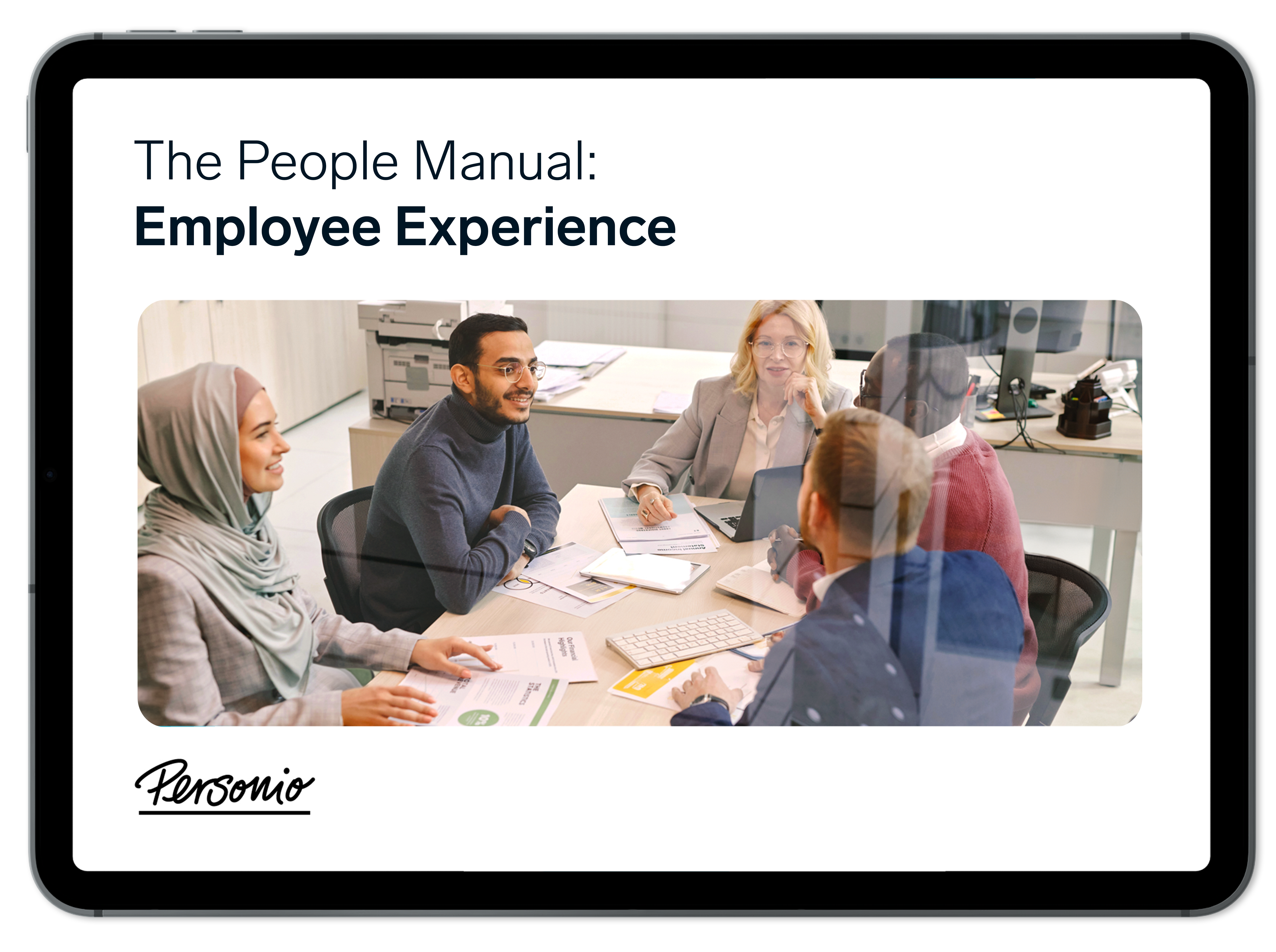Are fringe benefits the best benefits?

In this article, we will take a look at fringe benefits and fringe benefits examples that help boost employee attraction, retention, and engagement. Ultimately, we will also offer insight into which of these benefits matter the most.
Ready to focus on every element of employee experience? Download our guide.What Are Fringe Benefits?
Fringe benefits are additional compensations provided by an employer beyond an employee's direct wages or salaries. They can be monetary (such as bonuses and allowances) or non-monetary (such as subsidised meals, paid holidays and pension plans).
While some fringe benefits may be seen as extra perks, it's important to note that certain benefits are legally required and examples exclude regular cash compensations like salaries and bonuses.
Types of Fringe Benefits
Let’s break down the two key types of fringe benefits…
Core Benefits | Fringe Benefits |
|---|---|
A minimum number of paid vacation days per year | Extra vacation days for additional time off |
Workplace pension plan (employee retirement plan) | Employee stock option plan (ESOP) |
Protected leave (such as parental leave, carer’s leave, adoptive leave) | Additional types of leave (like sabbatical or mental wellness leave) |
Income protection | Flexible working arrangements |
Why Are Fringe Benefits Important?
When it comes to fringe benefits, companies can and should get creative.After all, when they listen to employees and offer them benefits that matter to them, they can start to truly compete in order to make themselves an attractive employer. That’s because these benefits are not mandatory, and employees (and potential employees) take notice.
Think of fringe benefits as powerful tools organisations can use to win over and keep the best employees (click here to read our guide to further employee retention strategies).
Are Fringe Benefits Becoming More Popular?
Whether we are going through or in the wake of the "Great Resignation" employers know the true value of talent in today’s marketplace. Top employees, high performers, and leaders have never been more important.
In addition to that, they have never been more difficult to attract and retain, and it’s why fringe benefits are so important. They matter because top talent wants more than an interesting role and a good paycheque. Today’s professionals expect benefits to support “the whole person.”
Throughout the Covid-19 pandemic, this only became more prominent. A recent survey of hundreds of company leaders in the UK showed that nearly half (46%) say their organisations have added new benefits as a result of the crisis.
According to this report, the most in-demand fringe benefits include:
Flexibility to work from home
Wellness support
Pension/Retirement plan
Even prior to 2020, employee surveys pointed out how much fringe benefits matter. In a 2019 UK study, 66% of employees rated these benefits equal to or more important than their salaries. Moreover, 14% of respondents said they would accept more benefits in lieu of a pay raise.
Employee engagement also partly turns on the perceived value of workplace benefits. One large-scale employee happiness study found that nearly all respondents (92%) believed that fringe benefits were important to their job satisfaction.
In that same study, a significant number of employees very satisfied with their perks also had high self-reported levels of engagement. This should come as no surprise. Benefits demonstrate how much a company appreciates its employees, and that appreciation is returned in loyalty and engagement.
Which Fringe Benefits Examples Should a Company Consider?
Here’s a quick overview of the most popular fringe benefits (before we dive into each):
Fringe Benefit | Example |
|---|---|
Mental Health & Wellness | Things like self-care days for employees to recharge |
Private Health Insurance | Insurance to help encourage to put their health first |
Pension Scheme | Retaining employees for years by offering future security |
Training & Development | Helping employees get better and better at what they do |
Flexible Working Arrangements | Allowing employees to do their best work, where it works best for them |
Sabbaticals | Offering an opportunity for employees to recharge and pursue their passions |
Fringe benefit programs should be designed to have a meaningful impact on an employee’s life. Here are the six most meaningful perks companies should consider offering:
1. Mental Health & Wellness
Employees en masse have quickly realised the need to prioritise self-care. Many have experienced first-hand the strong link between mental health and work performance.
Therefore, the more wellness perks a company can provide, the better. That’s because employee satisfaction, and productivity, are likely to follow. Employee wellbeing metrics help illustrate that story even more.
Wellness benefits are essentially a bundle of initiatives designed to help employees avoid illness while improving their mental and physical health. These can include:
Online or telephone counselling services
Meditation classes
Gym memberships or onsite fitness facilities
Yoga or other exercise classes
Smoking cessation and weight-loss courses
Training programs for stress management, resiliency, and other forms of self-care
Nutrition counselling
Vouchers for massages and other relaxation techniques
HR departments should consider implementing employee surveys to narrow down which wellness benefits their employees want the most, or experimenting with short programs and measuring the impact afterwards.
Download our free employee survey template today to gain measurable insights into your workforce.
Half a decade of insights on employee experience

Our "People Manual" covers all things related to employee experience and developing initiatives that result in more engaged employees. Grab your free copy right now.
Download It Today2. Private Health Insurance
Most professionals have come to expect companies to offer this fringe benefit. And, it is quite common in remuneration packages. Providing access to a high standard of healthcare, through company-sponsored private health insurance cover, has numerous advantages.
For the business, it can lead to lower employee absenteeism and greater productivity. For employees, it offers privileges that can lead to better overall health, such as:
Shorter waiting times for appointments
Off-hour appointment times
Ability to see any health care provider for more personalised care
24-hour telemedicine services
Access to mental health treatment
Businesses may want to “sweeten the deal” by offering cover to include employees’ family members, too.
3. Pension Scheme
Surveys show that pensions and employee retirement plans are one of the most important in terms of fringe benefits. In fact, in one UK study, 62% of employees said that a company pension benefit was the most valuable benefit, followed by health insurance.
Workplace pensions encourage long-term financial security by enabling employees to build a pot of money for their retirement.
Businesses are required by law to provide a workplace pension scheme for eligible staff. The company provides a minimum monthly contribution and the employee adds a monthly contribution, too. Both amounts are a percentage of the employee’s salary.
Businesses that want to attract and retain the best employees, however, go above and beyond the legal minimum contribution amount. Some contribute as much as 9 – 10% of the salary each month — a strong incentive for employees looking to maximise the overall financial benefits they get from their employers.
Generous pension schemes are one of the best ways that a company can demonstrate it appreciates an employee’s hard work. It puts meaning behind the message that it cares about employees’ long-term wellbeing.
Along with a pension scheme, businesses should also educate employees about the importance of long-term retirement planning. Employees may opt-out of workplace pensions if they choose to, but a good pension communication plan will ensure they understand the huge advantages of this fringe benefit.
4. Training & Development
The strongest-performing employees are also likely the ones most interested in growing their careers beyond their current roles. A company’s ability to support this can boost its success in attracting and retaining valuable talent.
To this end, businesses can and should dedicate resources to providing learning and development benefits. This includes a range of incentives, like:
In-house training programs
Financial support for relevant university degree programs
Funding for certification or other job skills training
Job shadowing or rotation programs
Career mentoring programs
Subscriptions for online learning platforms
Such training or education opportunities can become part of an employee’s personal development plan, and send the signal that the employee can build a long-term career in the company rather than looking elsewhere once they are ready for a different role.
5. Flexible Working Arrangements
Employee demands for hybrid working conditions were already trending well before 2020. The pandemic only accelerated this need. What does a flexible working benefit look like exactly? It can cover a number of “non-traditional” work arrangements, such as:
Home office
Remote working
Flexible office hours
Extended leave
Job sharing
Compressed workweeks
Studies like this one from 2019 show that many employees believe flexibility benefits can lower stress, improve mental health, and help them better integrate work and personal lives.
Further to that, 30% of respondents said that being able to work flexibly would increase their productivity and morale.
Those are reasons enough to offer this fringe benefit example. During the pandemic, though, a lot of businesses have discovered that flexible working can function surprisingly well without any loss of productivity.
For their part, employees have grown accustomed to having more control over where, when, and how they work. Those factors together are driving a change in workplace norms that organisations must embrace (read more about how companies can grow using the organisation development method).
Companies should consider extending this benefit and maybe even experimenting with new areas of flexible working in order to keep engagement high. At Personio, we have done exactly that with our PersonioFlex hybrid working model.
6. Sabbatical Leave
A growing number of companies offer sabbaticals as a fringe benefit. These work to reward hard-working employees, entice new employees, and reduce attrition.
A sabbatical — or a career break lasting around four to 10 weeks — is usually given to employees who have achieved a certain number of years of service. For example, a company might allow employees to take a one-month sabbatical after working for at least three years.
Sabbaticals can be paid, partially paid, or unpaid, but they have one aim: to give employees time out to focus on their own interests, no strings attached. Many individuals use their time off to travel, do volunteer work, take a training course, immerse themselves in a hobby, care for a family member, or simply recharge.
Experts say the advantages of sabbatical leave for employers include:
Increase employee motivation and loyalty
Better reputation as an employer
Lower levels of burnout and demotivation
Higher staff retention
Infusion of fresh energy and ideas from those returning from sabbatical
Although it takes effort from HR and managers to organise these leaves of absence, sabbaticals are an attractive perk that supports the long-term wellbeing and growth of valued employees.
In an age where professionals increasingly want control over their time, this benefit gives them just that while making the company a more attractive place to work.
Fringe Benefits That Make A Measurable Difference
The number of fringe benefits an organisation can offer is practically endless — free food, onsite childcare, personal travel reimbursement, time off for volunteering, company cars, extra vacation, public transport subsidies, to name but a few. They all have advantages, depending on the needs of employees.
That is why companies looking to add or revamp their current benefits portfolio should start at the source. Survey employees to see which perks matter most to them, and build a benefits program from there.
